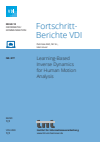Zusammenfassung
This dissertation deals with machine learning techniques for inverse dynamics of human motion. Inverse
dynamics refers to the derivation of acting forces and moments from the motion of a kinematic model. More precisely, the objective is to estimate joint torques, ground reaction forces and ground reaction moments at both feet based on the three-dimensional input motion of a skeletal model. The problem is solved using a data-driven machine learning approach, proposing several regression models that are particularly suitable with respect to limited data availability. The goal is to exploit the inherent strengths of machine learning, such as fast and noiseresistant data analysis. The described methods are able to predict underlying joint torques and exterior forces with high precision (on gait sequences: relative root mean squared errors of 7.0 %, 16.1 % and 11.9 % for reaction forces, reaction moments and joint moments which correspond to Pearson‘s correlation coefficients of 0.91, 0.83 and 0.82), while reducing computation times by two orders of magnitude compared to traditional optimization.
Contents
1 Introduction 1
1.1 Applications and Challenges of Inverse Dynamics . . ....
Schlagworte
Machine Learning Maschinelles Lernen Künstliche Neuronale Netze inverse Dynamik menschliche Bewegung Gelenkmomente Ganganalyse selbstüberwachtes Lernen inverse dynamics human motion joint moments gait analysis artificial neural networks self-supervised learning- 1–14 1 Introduction 1–14
- 15–22 2 Related work 15–22
- 23–61 3 Fundamentals 23–61
- 123–126 7 Conclusions 123–126
- 127–129 a Appendix 127–129
- 130–152 Bibliography 130–152

